Home
> Theory
/ Scales
>
Minor Phrygian
Phrygian is the 3rd mode of the major scale. Therefore, it begins on the 3rd degree of the major scale. This alone implies how the modes relate to one another and are connected to a single parent scale (the major scale). This concept will become clearer as we begin to paint the fuller modal picture.
Phrygian has a very distinctive sound, mainly because of one note (which we'll identify in a moment). Many musicians hear Phrygian as a natural part of flamenco and middle eastern music because of its traditional use and association.
The key thing to know is, flat 3rd and flat 7th in addition to the root (1) creates a minor 7th flavour, which are natural minor flavours (will work over most minor chords). The 5th is also a natural tone in minor 7th chords, giving us the complete minor seventh chord/arpeggio: 1 ♭3 5 ♭7.
Now for the other tones of phrygian...
First we have the flat/minor 2nd (♭2) which is unique to this mode, as the other minor modes use a major 2nd (2).
The minor 2nd, just like the minor 3rd or minor 7th, is so-called because it has been lowered by a semi-tone (half step or the equivalent of one fret position) from its "natural", major scale position.
The major scale can be seen as the reference scale (no sharp or flat intervals) from which we modify (flatten and sharpen) tones to create different modes/scales.
The flat 2nd is what gives Phrygian its flamenco and middle eastern sound. Listen below to the unique relationship between the minor 2nd and the root, as they are only a semi-tone apart. Below, I'm playing the same interval across 3 different octaves.
Root-2nd-Root interval: Click to hear
It's no surprise, then, that this particular interval is commonly used to convey "darker" more serious moods, which is why heavy metal has adopted it as one of its staple scales. Flamenco itself builds on this unique flat 2nd tension, using it to support the atmosphere of the music.
By adding in more intervals, we can get a good ear for Phrygian's signature sound, with the minor/flat 6th (♭6) being another key tension in the scale. More on how to use these notes over chords soon!
Click to hear
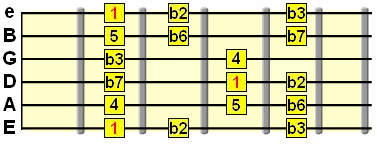
Like all scales, that pattern can be moved up and down the fretboard, depending on the root (1). For example, if the root note lied on E, the whole scale would be E Phrygian.
We'll look at expanding out of this box in a later lesson.
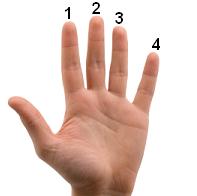 Here's a
suggested fingering for the above pattern...
Here's a
suggested fingering for the above pattern...
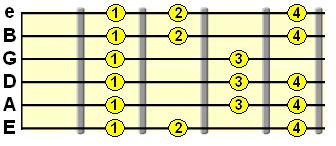
This pattern can be seen as the 3rd position box of Phrygian's parent major scale. Because Phrygian is the 3rd mode of the major scale, it uses the same pattern. In other words, learn the major scale's pattern across the neck, and you'll have Phrygian covered.
The minor 2nd
The important thing to know about the flat/minor 2nd is that it most often works best as a passing tone. That is, a bridge between two more stable tones (e.g. the sequence could go: 1 - ♭2 - 5. The minor 2nd is the bridge between the 1st and 5th tones). Lead guitar is all about bridging together starting and destination notes into meaningful phrases.
Hold the flat 2nd over a regular minor chord and it might sound a little... harsh. A more appropriate word is dissonant. This isn't so bad for flamenco or more exotic music, but only you can decide how you want it used in your music!
Take a listen to minor 2nd being held over a minor chord
Now listen to the flat 2nd being used as a passing tone between the 4th and ♭7. The sequence is: 1 ♭2 4 ♭2 1 ♭7 1
Take a listen
Sounds more natural doesn't it? It's getting that balance right - the flat 2nd can complement your solo, or it can ruin it if not used carefully and knowingly.
You can also use hammer-ons to touch on the flat 2nd, before quickly pulling off back to the root (1st). The idea is to know where the more stable tones are, so you can resolve to them when needed.
Minor 6th
Treat this note just like the minor 2nd in most circumstances - as a passing tone. It can be held in certain situations, but it's most often a note that needs resolving. That means it naturally leads to a more stable tone.
Below I play the minor 6th and resolve it to the 5th (a semitone lower), which is definitely a more stable tone, as it's part of the minor triad (1, ♭3, 5). This is what playing lead is all about - tension, resolution, tension, resolution etc.
Take a listen
Removing the minor 3rd
Many musicians like to remove the minor 3rd from Phrygian altogether, because doing so puts more emphasis on the flat 2nd, and the dark mood it creates. You'll also come to realise that a major 3rd actually works better in certain instances.
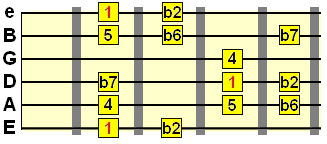
Now that we've removed the minor 3rd, the modified Phrygian mode could essentially be applied over major chords. However, in that instance, a major 3rd is often used in place of the minor 3rd, creating a scale/mode called Phrygian Dominant. More on this wonderful scale another time!
If you don't remove the minor 3rd, it's best used, like the flat 2nd and flat 6th, as a passing tone. It might sound strange that a minor mode can't make much effective use of the minor 3rd interval, but this is because Phrygian sounds more natural over a chord progression, rather than just a single minor chord. In other words, the chord progression puts the mode into context.
Pentatonic option
Notice how if you strip phrygian down to just the minor essentials we looked at earlier - 1 ♭3 5 ♭7 - but also keep the 4th intact, we get that familiar minor pentatonic scale:
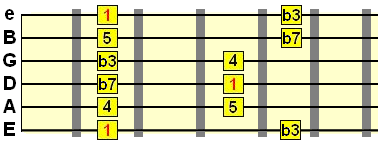
In fact, this works over any minor mode/scale that accomodates those tones. The reason I've brought it up in a mode lesson is because you can switch between regular, 7 tone (heptatonic) scales and 5 tone pentatonic scales to make your phrases/licks more dynamic. Mix it up a little.
It's also worth noting that Phrygian can work well over suspended chords (e.g. Asus2, Asus4). Suspended chords are where the 3rd has been replaced by another note - usually the 4th (suspended 4th chords). In this instance, the minor 3rd in Phrygian will be more effective as a passing tone over "sus" chords, just like the minor 2nd with most chords.
As mentioned before, using the minor 3rd can sound a bit out of place if not used properly in context, even though it's technically a minor scale, but using it as a passing tone can really bring out that haunting Phrygian sound.
As we're in the key of E (root note on E), we can also play an open fingering of the scale, with the lowest root note being the open E string.
Download the E Phrygian jam track here (right click and "save as")

Fret 12
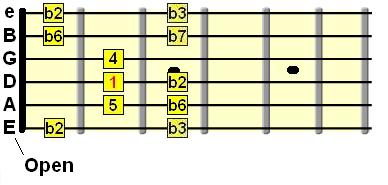
You can find more Phrygian jam tracks right here
Learn More Guitar Modes
Phrygian Dominant Mode
Learn Guitar Scales
Minor Phrygian Mode on Guitar
Just like in the other guitar modes lessons, before we learn how Phrygian (sometimes called minor Phrygian) works on guitar, we need to get to know Phrygian in theory. Only then will we know when to use it. Free scale
pattern cheat sheet Free scale
pattern cheat sheetEssential scale patterns that every guitarist must know... Click here to start now |
Phrygian is the 3rd mode of the major scale. Therefore, it begins on the 3rd degree of the major scale. This alone implies how the modes relate to one another and are connected to a single parent scale (the major scale). This concept will become clearer as we begin to paint the fuller modal picture.
Phrygian has a very distinctive sound, mainly because of one note (which we'll identify in a moment). Many musicians hear Phrygian as a natural part of flamenco and middle eastern music because of its traditional use and association.
Intervals of the Phrygian Mode
1
H ♭2 W
♭3 W 4
W
5 H ♭6
W ♭7 W 1
Don't know what the W's and H's mean? If so, take the intervals lesson before you go on.
So, just like other minor scales, Phrygian includes a flat/minor 3rd interval (as it's a minor mode) and a flat/minor 7th. As these two common elements of the minor modes was looked at in the preceding Dorian lesson, I won't repeat it!The key thing to know is, flat 3rd and flat 7th in addition to the root (1) creates a minor 7th flavour, which are natural minor flavours (will work over most minor chords). The 5th is also a natural tone in minor 7th chords, giving us the complete minor seventh chord/arpeggio: 1 ♭3 5 ♭7.
Now for the other tones of phrygian...
First we have the flat/minor 2nd (♭2) which is unique to this mode, as the other minor modes use a major 2nd (2).
The minor 2nd, just like the minor 3rd or minor 7th, is so-called because it has been lowered by a semi-tone (half step or the equivalent of one fret position) from its "natural", major scale position.
The major scale can be seen as the reference scale (no sharp or flat intervals) from which we modify (flatten and sharpen) tones to create different modes/scales.
The flat 2nd is what gives Phrygian its flamenco and middle eastern sound. Listen below to the unique relationship between the minor 2nd and the root, as they are only a semi-tone apart. Below, I'm playing the same interval across 3 different octaves.
Root-2nd-Root interval: Click to hear
It's no surprise, then, that this particular interval is commonly used to convey "darker" more serious moods, which is why heavy metal has adopted it as one of its staple scales. Flamenco itself builds on this unique flat 2nd tension, using it to support the atmosphere of the music.
By adding in more intervals, we can get a good ear for Phrygian's signature sound, with the minor/flat 6th (♭6) being another key tension in the scale. More on how to use these notes over chords soon!
Click to hear
Phrygian mode on guitar
So, like in the previous mode lessons, let's map out the intervals of Phrygian into a simple box pattern across the 6 strings of the guitar...
Like all scales, that pattern can be moved up and down the fretboard, depending on the root (1). For example, if the root note lied on E, the whole scale would be E Phrygian.
We'll look at expanding out of this box in a later lesson.
 Here's a
suggested fingering for the above pattern...
Here's a
suggested fingering for the above pattern...
This pattern can be seen as the 3rd position box of Phrygian's parent major scale. Because Phrygian is the 3rd mode of the major scale, it uses the same pattern. In other words, learn the major scale's pattern across the neck, and you'll have Phrygian covered.
Playing Phrygian over chords
We know from above that Phrygian is a minor mode, so we know it will, theoretically at least, work over minor chords. Let's now look at how the other tones of Phrygian interact with minor chords.The minor 2nd
The important thing to know about the flat/minor 2nd is that it most often works best as a passing tone. That is, a bridge between two more stable tones (e.g. the sequence could go: 1 - ♭2 - 5. The minor 2nd is the bridge between the 1st and 5th tones). Lead guitar is all about bridging together starting and destination notes into meaningful phrases.
Hold the flat 2nd over a regular minor chord and it might sound a little... harsh. A more appropriate word is dissonant. This isn't so bad for flamenco or more exotic music, but only you can decide how you want it used in your music!
Take a listen to minor 2nd being held over a minor chord
Now listen to the flat 2nd being used as a passing tone between the 4th and ♭7. The sequence is: 1 ♭2 4 ♭2 1 ♭7 1
Take a listen
Sounds more natural doesn't it? It's getting that balance right - the flat 2nd can complement your solo, or it can ruin it if not used carefully and knowingly.
You can also use hammer-ons to touch on the flat 2nd, before quickly pulling off back to the root (1st). The idea is to know where the more stable tones are, so you can resolve to them when needed.
Minor 6th
Treat this note just like the minor 2nd in most circumstances - as a passing tone. It can be held in certain situations, but it's most often a note that needs resolving. That means it naturally leads to a more stable tone.
Below I play the minor 6th and resolve it to the 5th (a semitone lower), which is definitely a more stable tone, as it's part of the minor triad (1, ♭3, 5). This is what playing lead is all about - tension, resolution, tension, resolution etc.
Take a listen
Removing the minor 3rd
Many musicians like to remove the minor 3rd from Phrygian altogether, because doing so puts more emphasis on the flat 2nd, and the dark mood it creates. You'll also come to realise that a major 3rd actually works better in certain instances.

Now that we've removed the minor 3rd, the modified Phrygian mode could essentially be applied over major chords. However, in that instance, a major 3rd is often used in place of the minor 3rd, creating a scale/mode called Phrygian Dominant. More on this wonderful scale another time!
If you don't remove the minor 3rd, it's best used, like the flat 2nd and flat 6th, as a passing tone. It might sound strange that a minor mode can't make much effective use of the minor 3rd interval, but this is because Phrygian sounds more natural over a chord progression, rather than just a single minor chord. In other words, the chord progression puts the mode into context.
Pentatonic option
Notice how if you strip phrygian down to just the minor essentials we looked at earlier - 1 ♭3 5 ♭7 - but also keep the 4th intact, we get that familiar minor pentatonic scale:

In fact, this works over any minor mode/scale that accomodates those tones. The reason I've brought it up in a mode lesson is because you can switch between regular, 7 tone (heptatonic) scales and 5 tone pentatonic scales to make your phrases/licks more dynamic. Mix it up a little.
It's also worth noting that Phrygian can work well over suspended chords (e.g. Asus2, Asus4). Suspended chords are where the 3rd has been replaced by another note - usually the 4th (suspended 4th chords). In this instance, the minor 3rd in Phrygian will be more effective as a passing tone over "sus" chords, just like the minor 2nd with most chords.
Phrygian jam track
You don't have to play anything too elaborate at the moment. Just explore different sequences of Phrygian's intervals over the E minor backing track below and hear how each tone in the scale interacts with the music. Experiment! You'll have this jam track for life (download it!), so you can keep coming back to it as you improve.As mentioned before, using the minor 3rd can sound a bit out of place if not used properly in context, even though it's technically a minor scale, but using it as a passing tone can really bring out that haunting Phrygian sound.
As we're in the key of E (root note on E), we can also play an open fingering of the scale, with the lowest root note being the open E string.
Download the E Phrygian jam track here (right click and "save as")

Fret 12

You can find more Phrygian jam tracks right here
| |
Tweet |
Stay updated and learn more
Sign up to the newsletter for updates and grab your free Uncommon Chords book
Sign up to the newsletter for updates and grab your free Uncommon Chords book
Related
Learn More Guitar Modes
Phrygian Dominant Mode
Learn Guitar Scales








